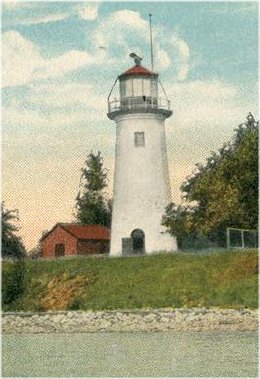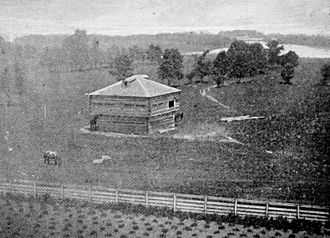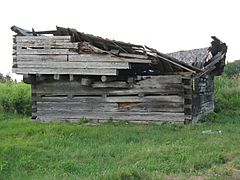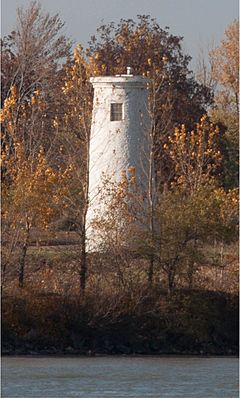Bois Blanc Island Lighthouse and Blockhouse facts for kids
 |
|
| Circa 1919 | |
| Coordinates | 42°05′13″N 83°7′10″W / 42.08694°N 83.11944°W |
|---|---|
| Year first constructed | 1836 |
| Deactivated | 1950s |
| Construction | Limestone and rubble tower |
| Tower shape | tapered cylindrical tower |
| Height | 40 feet (12 m) |
| ARLHS number | CAN-049 |
| Bois Blanc Blockhouse | |
|---|---|

One of three blockhouses in 1893
|
|
| General information | |
| Type | Blockhouse |
| Location | Bois Blanc Island |
| Town or city | Amherstburg |
| Country | Canada |
| Renovated | 2012–2014 |
| Owner | Dominic Amicone |
| Technical details | |
| Floor count | 2 |
The Bois Blanc Island Lighthouse and Blockhouse is a special place in Canada. It is known as a National Historic Site. You can find it on Bois Blanc Island in Ontario. This island is one of many in the Detroit River. The site includes a lighthouse, which is owned by Parks Canada. It also has a blockhouse, which is owned by a private person.
Contents
What is the Bois Blanc Lighthouse?
The lighthouse is a tall, white stone tower. It stands at the south end of Bois Blanc Island. This spot is close to where the Detroit River flows into Lake Erie. The government of Upper Canada built the lighthouse in 1836. Its main goal was to make travel safer on Lake Erie. More ships were using the lake after the Welland Canal was finished in 1829.
The lighthouse was designed like other towers built between the 1830s and 1860s. A group of people from the government chose the design. We don't know for sure who designed it. Some local stories say it was Andrew Kemp, an engineer from Amherstburg. John Cook from Detroit was given the job to build it.
How the Lighthouse Was Built
The tower is made of limestone and rough stones. It gets narrower as it goes up. At its base, it is about 5.5 meters (18 feet) wide. The tower stands about 12 meters (40 feet) tall. The top part has a stepped design. There are three windows at different heights. The limestone might have come from Kingston. It might have been used as heavy material to balance a ship.
What is the Bois Blanc Blockhouse?
The blockhouse was the last of three built on the island. It was put up in 1838. It was part of a defense plan for Fort Malden. You can find it near the lighthouse on the south side of Bois Blanc Island. The first building was made from strong, square-cut white oak logs. It had narrow openings for guns on each wall.
The upper floor was where soldiers slept. It had openings in the floor to drop things on attackers below. There were also underground storage areas. One was for gunpowder, and the other was for food. Inside the blockhouse today, you can see old items. These were found when people dug around the building.
Restoring the Blockhouse
By 2010, the blockhouse was in very bad shape. The top floor and stairs were gone. The walls were almost falling down, and the roof was collapsing. The private owner of the building wants to give it to Parks Canada. This will happen once the restoration is finished. With his permission, many volunteers started to fix the building.
Workers raised the building about 46 centimeters (18 inches). They built a new concrete foundation underneath. A log floor was put in, covered with rough pine boards. A thick door with iron parts was also installed. In 2013, island residents raised $5,000. This money, along with other donations, paid for a new cedar shake roof.
Lighthouse History in the 20th and 21st Centuries
The original light system in the lighthouse was updated many times. In 1954, a fire destroyed the light room. A steel frame replaced it. The lighthouse stopped being used in the late 1950s. In 1961, Parks Canada took ownership. They removed the steel frame in the 1970s. They also fixed the door and the fan light above it. Sadly, vandals destroyed these, so the entrance was blocked with stones.
For almost 90 years, the main Lighthouse keeper was from the Hackett family. James Hackett was the keeper from 1836 to 1870. Then came Andrew (1870–1901), Agnes (1901–1910), and Charles R. Hackett (1910–1924). In 2015, this lighthouse was one of 74 protected under the Heritage Lighthouse Protection Act. It was also one of 42 lighthouses owned by Parks Canada.
Becoming a National Historic Site
In 1955, the Bois Blanc Island Lighthouse and Blockhouse became a National Historic Site of Canada. It was chosen for several reasons. It is close to Fort Malden, another National Historic Site. The blockhouses helped defend Fort Malden. It was also the place of an attack in January 1838. This attack was by "Canadian rebels and their American supporters" and it did not succeed. The site is open for visitors, but you cannot go inside the tower.
Images for kids






